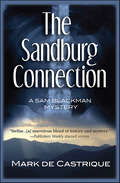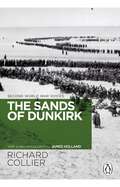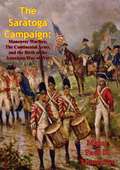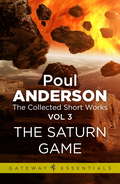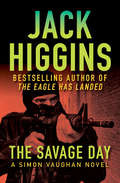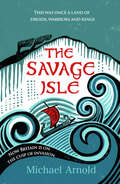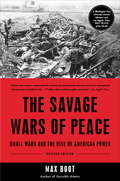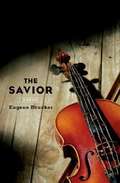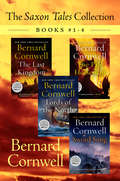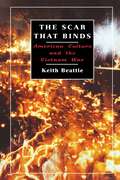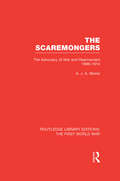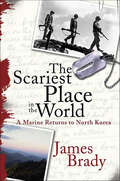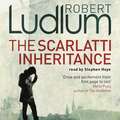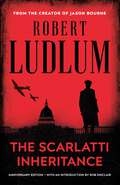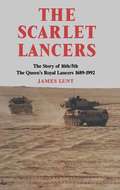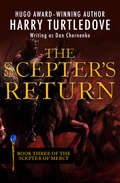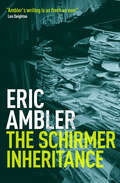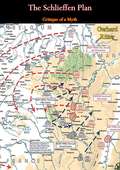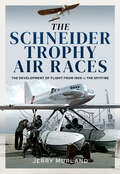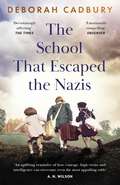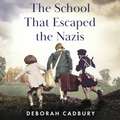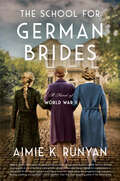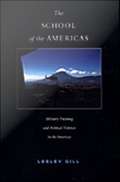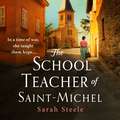- Table View
- List View
The Sandburg Connection: A Sam Blackman Mystery (Blackman Agency Investigations #3)
by Mark de Castrique"[A] marvelous blend of history and mystery..." —Publishers Weekly STARRED reviewIt should have been routine, a simple assignment for PI Sam Blackman and his partner Nakayla Robertson. Follow a history professor who's suing a spinal surgeon for malpractice and catch her in physical activities that undercut her claim.When professor Janice Wainwright visits Connemara, Carl Sandburg's home in Flat Rock, N.C., and climbs the arduous trail to the top of Glassy Mountain, Sam believes he has the evidence needed to expose her—until he finds the woman semiconscious and bleeding on the mountain's granite outcropping. Her final words: "It's the Sandburg verses. The Sandburg verses."As the person to discover the dying woman, Sam becomes the first suspect. An autopsy reveals painkillers in her blood and solid proof of the surgeon's errors. Why did this suffering woman attempt to climb the mountain? Did she stumble and fall? Did someone cause her death?A break-in at the Wainwright farmhouse and the theft of Sandburg volumes convince Sam someone is seeking potentially deadly information. But what did Pulitzer Prize winner Sandburg have in his literary collection that inspires multiple murders? And who will be targeted next?
The Sands of Dunkirk (Second World War Voices)
by Richard CollierPart of the SECOND WORLD WAR VOICES series, with a new introduction by bestselling historian James Holland, and in partnership with the podcast We Have Ways of Making You Talk, presented by comedian Al Murray and James HollandMay 1940: In the face of a lightning German advance, the British Army found themselves, stunned, broken, beaten, their backs truly against the wall on the sands of the north French coast.And yet it was on the beaches of Dunkirk that the seeds of a remarkable victory were sown. The evacuation of over three hundred thousand men in ships of all sizes was a logistical feat which has never been seen, before or since.This vivid, visceral story takes you inside the making of a miracle: the story of eight frantic days, as the net tightened around the beleaguered troops, told from all sides, as the enemy draws closer and the bombardment intensifies, in the words of those who were there. It is impossible to get closer to experiencing this legendary action.
The Saratoga Campaign: Maneuver Warfare, the Continental Army, and the Birth of the American Way of War
by Maj. Paul D. MontanusThe Saratoga Campaign (June-October 1777) was a watershed event for the United States. The American conduct of the campaign is a textbook study in the application of the tenets of maneuver warfare principles at the operational and tactical levels. General Schuyler's brilliant shaping campaign against the British Forces as they advanced from Fort Ticonderoga to Albany forced General Burgoyne to detach elements of his force, which the Americans were able to isolate, mass forces against, and destroy. Ultimately, Schuyler's shaping cased the British campaign to culminate prior to the main engagements, known as the first and second battles of Saratoga. Occupying a prepared Defensive Position North of Saratoga, the Americans, led by General Arnold, conducted a forward oriented Defense that seized the initiative from the British and disrupted their preconceived plans. The American counter-attacks which demonstrated the American Mastery of seeking gaps and avoiding surfaces, attrited the British Force to such an extent that they were forced to surrender. The victory of the makeshift American Force over the Professional British-Led Force demonstrates the superiority of maneuver warfare versus Attritionist Techniques, and is of contemporary interest to the USMC.Richly illustrated throughout.
The Saturn Game: The Collected Short Stories Volume 3
by Poul AndersonPoul Anderson's stories are classics from the golden age of science fiction and beyond. A master storyteller, Anderson wrote tales ranging from the immediate to the distant future, from Earth to far-flung galaxies, from hard science fiction to fantasy - all the elements stirred and blended as only Anderson could!THE SATURN GAME is the third volume of The Collected Works of Poul Anderson and collects his best works from a writing career that spans over 50 years.This volume contains 18 stories including:The Saturn Game (Hugo and Nebula winner)Hunter's Moon (Hugo winner)No Truce with Kings (Hugo winner)Operation SalamanderSam HallThe Only Game in TownHiding PlaceA Tragedy of ErrorsPlus: seven limericks and two untitled songs!
The Savage Day (The Simon Vaughan Novels #2)
by Jack HigginsA desperate man goes up against the IRA to buy his freedom in this heart-racing thriller from the New York Times–bestselling author of The Midnight Bell. After surviving the war in Korea, Simon Vaughan decided the only loyalty he had was to the man in the mirror. For a while, the high-risk job of arms dealing seemed to be just the life for him. Too bad the Greek authorities didn&’t see it that way when they tossed him in prison. But now he&’s gotten a reprieve from an unlikely source: the British Army. And if he wants out, he&’s going to have to play their game. It seems that the Irish Republican Army has made off with a half-million dollars in gold bullion. The Brits want it back. And their best bet is to send someone tough, resourceful, and completely expendable—which is Vaughan to the letter. Venturing into the bloody underground of a violent rebellion, Vaughan must navigate a deadly maze of friends, foes, and those in between, if he&’s going to get the gold, get the bad guys, and get out in one piece . . . The author of the Sean Dillon and Liam Devlin series, including the classic The Eagle Has Landed, Jack Higgins has enthralled millions of readers around the world with his explosive novels of spies and espionage, heroes and villains, and fast-paced storytelling that have made him a true mastermind of the modern thriller.
The Savage Isle (Savage Isle series)
by Michael Arnold'The lost world of the ancient Britons is vividly and memorably recreated' The TimesThe old ways are dying, and a mighty empire is reaching out across the sea.Britannia, 42AD. The wild island at the fringe of the known world is in chaos.Cunobelin, High King of the Britons, is dead. His heirs, warrior princes Togodubnos and Caratacos, have spurned the careful alliances that kept the irresistible might of the Roman Empire from Britannia's shores for so long.In this land of warriors, druids and kings, riven by conflict, orphan boy Cullen must fight for survival within a tribe he despises. Captured by the Catuvellauni after a brutal raid on his own Atrebates tribe, he must find his purpose swiftly if he is to avoid the murderous attentions of the chief druid.As the Britons turn inward, jostling for dominion, avaricious eyes look on from across the Narrow Sea. The mighty legions gatherThis is the epic story of Britain on the cusp of the Roman conquest, of a clash of civilisations and the last cries of resistance from a doomed way of life.Praise for The Savage Isle 'There are several dawns in the history of these British Isles, but the dark before each one was never so impenetrable as that which preceded the Roman invasion of AD 43. Michael Arnold has shone a fascinating light on this period, capturing perfectly the anxiety, the high stakes and the conflicting interests of the moment. A warrior coming-of-age story unlike any I've ever read, with prose that sings like a druidic bard. Authentic, poetic, powerful. An epic overture to this savage isle's history' Theodore Brun, author of A Burning Sea'The Savage Isle tells the story of Iron Age Britain on the cusp of the Roman invasion. The evocation of the land of Ancient Britannia and the customs and way of life of the Ancient Britons is vividly and imaginatively brought to life' Alex Gough, author of Caesar's SoldierMichael Arnold's rich imagining of the island of Britain on the eve of the Roman invasion is lyrical and powerfully evoked but delicately described and packed with authentic human emotion... Simply masterful... will have you turning the pages long into the night' Angus Donald, author of The Last Berserker
The Savage Wars Of Peace: Small Wars And The Rise Of American Power
by Max BootAmerica's "small wars," "imperial wars," or, as the Pentagon now terms them, "low-intensity conflicts," have played an essential but little-appreciated role in its growth as a world power. Beginning with Jefferson's expedition against the Barbary Pirates, Max Boot tells the exciting stories of our sometimes minor but often bloody landings in Samoa, the Philippines, China, Haiti, the Dominican Republic, Nicaragua, Mexico, Russia, and elsewhere. Along the way he sketches colorful portraits of little-known military heroes such as Stephen Decatur, "Fighting Fred" Funston, and Smedley Butler. From 1800 to the present day, such undeclared wars have made up the vast majority of our military engagements. Yet the military has often resisted preparing itself for small wars, preferring instead to train for big conflicts that seldom come. Boot re-examines the tragedy of Vietnam through a "small war" prism. He concludes with a devastating critique of the Powell Doctrine and a convincing argument that the armed forces must reorient themselves to better handle small-war missions, because such clashes are an inevitable result of America's far-flung imperial responsibilities.
The Savior: A Novel
by Eugene DruckerViolinist struggles with issues of integrity during World War II.
The Saxon Tales Collection: Books #1-4
by Bernard CornwellThe Saxon Tales Collection: Books #1-4: The Last Kingdom, The Pale Horseman, Lords of the North, and Sword Song
The Scar That Binds: American Culture and the Vietnam War
by Keith BeattieAt the height of the Vietnam War, American society was so severely fragmented that it seemed that Americans may never again share common concerns. The media and other commentators represented the impact of the war through a variety of rhetorical devices, most notably the emotionally charged metaphor of "the wound that will not heal." References in various contexts to veterans' attempts to find a "voice," and to bring the war "home" were also common. Gradually, an assured and resilient American self-image and powerful impressions of cultural collectivity transformed the Vietnam war into a device for maintaining national unity. Today, the war is portrayed as a healed wound, the once "silenced" veteran has found a voice, and the American home has accommodated the effects of Vietnam. The scar has healed, binding Americans into a union that denies the divisions, diversities, and differences exposed by the war. In this way, America is now "over" Vietnam. In The Scar That Binds, Keith Beattie examines the central metaphors of the Vietnam war and their manifestations in American culture and life. Blending history and cultural criticism in a lucid style, this provocative book discusses an ideology of unity that has emerged through widespread rhetorical and cultural references to the war. A critique of this ideology reveals three dominant themes structured in a range of texts: the "wound," "the voice" of the Vietnam veteran, and "home." The analysis of each theme draws on a range of sources, including film, memoir, poetry, written and oral history, journalism, and political speeches. In contrast to studies concerned with representations of the war as a combat experience, The Scar That Binds opens and examines an unexplored critical space through a focus on the effects of the Vietnam War on American culture. The result is a highly original and compelling interpretation of the development of an ideology of unity in our culture.
The Scaremongers: The Advocacy of War and Rearmament 1896-1914 (Routledge Library Editions: The First World War)
by A. J. MorrisThis revealing book illustrates how the passion for war was fostered and promoted. The author provides detailed evidence of how and why an image of Germany as a nation determined upon world hegemony was deliberately promoted by a group of British newspaper editors, proprietors and journalists. This book examines the role of these ‘scaremongers’. Were they as influential as their critics claimed? Did they influence the minds of their readers and shape events? Were they guilty of creating a climate of opinion that ensured that their prophecies of inevitable Anglo-German war became fact in 1914?
The Scariest Place in the World: A Marine Returns to North Korea
by James BradyA memoir from the New York Times bestselling author of Warning of War and Marines of Autumn, James Brady's The Scariest Place in the World. Half a century after he fought there as a young lieutenant of Marines, James Brady returns to the brooding Korean ridgelines and mountains to sound taps for a generation. It's been years since Brady first wrote of Korea in The Coldest War, drawing raves from Walter Cronkite and The New York Times, which called it "a superb personal memoir of the way it was." In the spring of 2003, Brady and Pulitzer Prize–winning combat photographer Eddie Adams flew in Black Hawk choppers and trekked the Demilitarized Zone where it meanders into North Korea, interviewing four-star generals and bunking in with tough U.S. recon troops, in Brady's words, "raw meat on the point of a sharpened stick." Brady recalls that first time on bloody Hill 749, the men who died there, what happened to the Marines who lived to make it home, and experiences yet again the emotional pull of a lifelong love affair with the Corps in which they all served. Brady summons up the past and illuminates the present, be it the Korea of "the forgotten war," the Yanks who fought there long ago, or today's soldiers standing wary sentinel over "the scariest place in the world." The result is uplifting, inspiring, often heartbreaking, and this Brady memoir proves as powerful as his first.
The Scarlatti Inheritance: Action, adventure, espionage and suspense from the master storyteller
by Robert LudlumIn Washington, word is received that an elite member of the Nazi High Command is willing to defect and divulge information that will shorten the war. But his defection entails the release of the ultra-top-secret file on the Scarlatti Inheritance - a file whose contents will destroy many of the Western world's greatest and most illustrious reputations if they are made known...THE SCARLATTI INHERITANCE is a spellbinding story of international terror and intrigue, greed and cunning, suspense and murder.Read by Stephen Hoye. Stephen Hoye has worked as a professional actor in London and Los Angeles for over 30 years. Trained at Boston University and The Guildhall in London, he has done six feature films, several television series, both drama and comedy, and appeared in London's West End on five occasions.(p) 2012 Penguin Random House LLC
The Scarlatti Inheritance: Action, adventure, espionage and suspense from the master storyteller
by Robert LudlumIncludes a new introduction from bestselling author Rob SinclairThe Third Reich is in its death struggle...A spellbinding story of international terror and intrigue, greed and cunning, suspense and murder from the No. 1 bestselling master storyteller.'The real titan of the genre is Robert Ludlum' GQ'THE SCARLATTI INHERITANCE has drive and excitement from first page to last. Robert Ludlum is an ingenious storyteller' Mario PuzoIn Washington, word is received that an elite member of Nazi High Command is willing to defect and divulge information that will shorten the war. But his defection entails the release of the ultra top-secret file on the Scarlatti Inheritance - a file whose contents will destroy many of the Western world's greatest and most illustrious reputations if they are made known...
The Scarlet Lancers: The Story of the 16th/5th: The Queen's Royal Lancers, 1689–1992 (Military History Ser.)
by James LuntThe 16th/5th Queen's Royal Lancers have long had the reputation of being one of the most efficient, and at the same time one of the least flamboyant, of the British cavalry regiments. The regiment, as it exists today, is the product of the amalgamation after the Great War of two cavalry regiments whose combined battle honours bear witness to their distinguished services. It was first raised as the Royal Dragoons of Ireland, and more recently has returned in triumph from the Gulf War, prior to which not one member of the regiment had seen action, apart from tours in Northern Ireland. In writing this history of the regiment he once commanded, General Lunt offers evidence of the continuing value of tradition and esprit de corps on which the regimental system of the British Army has for so long been based.
The Scent of Snowflowers: A Chronicle of Faith, Hope and Survival in War-ravaged Budapest
by R. L. KleinThe true story of a Jewish family and the Gentiles who hid and protected them during World War II in Budapest.
The Scepter's Return (The Scepter of Mercy #3)
by Harry TurtledoveWith the survival of their world at stake, two rival kings must unite to recover the magical talisman that will enable them to defeat a malevolent god When Avornis falls, the Banished One will reign supreme. Rival kings Lanius and Grus each covet solitary power, but realize that a kingdom divided cannot stand against the evil god who enslaves the minds of men through their nightmares. Once, Avornis was safe from his dark influence, protected by a powerful talisman supplied by the pantheon of deities who expunged the immortal called Milvago from their ranks. But that was centuries earlier, before the Scepter of Mercy was lost, and only through its recovery can Avornis survive. Now, Lanius has a daring--most likely impossible--plan, but it requires the cooperation of his fellow ruler, the warrior and usurper king Grus. If they fail to work together they will die together nevertheless, along with everything that is good and right in their world. Hugo Award winner Harry Turtledove brings his Scepter of Mercy trilogy to a spectacular end with a story of courage, conflict, and selfless sacrifice. In The Scepter's Return, as in the previous books of the series, the acclaimed world-builder reimagines epic fantasy, leaving his own special imprint on the popular genre much as he has done with the alternate history for which he is so justifiably renowned.
The Schirmer Inheritance
by Eric AmblerA lawyer unearths deadly secrets reaching back to the Napoleonic era in this “masterful contribution to the literature of international dirty work” (The New Yorker).Former WWII bomber pilot George Cary has a promising postwar career ahead of him as a newly minted lawyer, though his first assignment at his prestigious Philadelphia law firm isn’t exactly glamorous. He’s been tasked with going through the copious, dusty files on the Schneider Johnson case, in which the search for an heir to a family fortune yielded no results.When Cary discovers something despite the dead ends and false claims, it leads him to Europe where he begins to unravel a twisting, secret history. Soon, Cary is drawing connections between a deserter from Napoleon’s defeated army to a guerrilla fighter in post-war Greece. Determined to pursue the whole truth, Cary finds himself in a dangerous situation where survival depends more on his military experience than anything he learned in law school.
The Schlieffen Plan: Critique of a Myth
by Gerhard Ritter Andrew Eva Wilson Sir B. H. Liddell HartThe Schlieffen Plan was the name given after World War I to the theory behind the German invasion of France and Belgium on 4 August 1914. In 1905-1906 Field Marshal Alfred von Schlieffen, the Chief of the Imperial Army German General Staff from 1891-1906, had devised a deployment plan for a war-winning offensive, in a one-front war against the French Third Republic. After the war, the German official historians of the Reichsarchiv and other writers, described the plan as a blueprint for victory.Post-war writing by senior German officers and the Reichsarchiv historians managed to establish a commonly accepted narrative that it was Schlieffen’s successor Helmuth von Moltke the Younger’s failure to follow the blueprint, rather than German strategic miscalculation, that resulted in four years of attrition warfare.In 1953, renowned historian Prof. Gerhard Ritter Schlieffen’s unearthed Schlieffen’s papers during a visit to the United States, and he published his findings in the book Der Schlieffenplan: Kritik eines Mythos, presented here in its 1958 English translation, The Schlieffen Plan: Critique of a Myth. It proved to be an important historical publication, as it set in motion a period of revision, when the details of the supposed Schlieffen Plan were subjected to scrutiny and contextualisation.In Der Schlieffen Plan, Prof. Ritter presents the full text of Schlieffen’s military testament, and the relevant parts of other memoranda which shed light on the evolution of the Plan. They are preceded by Professor Ritter’s masterly exposition of their content and significance, while his accompanying notes add to the illuminating effect.“FOR two generations the Schlieffen Plan has been a magic phrase, embodying one of the chief mysteries and ‘might have beens’ of modern times. The mystery is cleared up and the great ‘If’ analysed in Gerhard Ritter’s book—a striking contribution to twentieth-century history.”—B. H. Liddell Hart
The Schneider Trophy Air Races: The Development of Flight from 1909 to the Spitfire
by Jerry MurlandThe history of the Schneider Trophy is the history of aircraft development.When Jacques Schneider devised and inaugurated the Coupe d’Aviation Maritime race for seaplanes in 1913, no-one could have predicted the profound effect the Series would have on aircraft design and aeronautical development, not to mention world history. Howard Pixton’s 1914 victory in a Sopwith Tabloid biplane surprisingly surpassed the performance of monoplanes and other manufacturers turned back to biplanes. During The Great War aerial combat was almost entirely conducted by biplanes, with their low landing speeds, rapid climb rates and maneuverability. Post-war the Races resumed in 1920. The American Curtiss racing aircraft set the pattern for the 1920s, making way for Harold Mitchell’s Supermarines in the 1930’s. Having won the 1927 race at Venice Mitchell developed his ground-breaking aircraft into the iconic Spitfire powered by the Rolls-Royce Merlin engine. This new generation of British fighter aircraft were to play a decisive role in defeating the Luftwaffe and thwarting the Nazis’ invasion plans. This is a fascinating account of the air race series that had a huge influence on the development of flight.
The School That Escaped the Nazis
by Deborah Cadbury'All the violence I had experienced before felt like a bad dream. It was a paradise. I think most of the children felt it was a paradise.'In 1933, as Hitler came to power, schoolteacher Anna Essinger hatched a daring and courageous plan: to smuggle her entire school out of Nazi Germany. Anna had read Mein Kampf and knew the terrible danger that Hitler's hate-fuelled ideologies posed to her pupils. She knew that to protect them she had to get her pupils to the safety of England. But the safe haven that Anna struggled to create in a rundown manor house in Kent would test her to the limit. As the news from Europe continued to darken, Anna rescued successive waves of fleeing children and, when war broke out, she and her pupils faced a second exodus. One by one countries fell to the Nazis and before long unspeakable rumours began to circulate. Red Cross messages stopped and parents in occupied Europe vanished. In time, Anna would take in orphans who had given up all hope; the survivors of unimaginable horrors. Anna's school offered these scarred children the love and security they needed to rebuild their lives, showing them that, despite everything, there was still a world worth fighting for.Featuring moving first-hand testimony, and drawn from letters, diaries and present-day interviews, The School That Escaped the Nazis is a dramatic human tale that offers a unique child's-eye perspective on Nazi persecution and the Holocaust. It is also the story of one woman's refusal to allow her beliefs in a better, more equitable world to be overtaken by the evil that surrounded her.
The School That Escaped the Nazis
by Deborah CadburyThe extraordinary true story of progressive schoolteacher, Anna Essinger, the woman who defied Hitler, smuggling her school and its pupils from Nazi Germany to the safety of England.'All the violence I had experienced before felt like a bad dream. It was a paradise. I think most of the children felt it was a paradise.'In 1933, as Hitler came to power, schoolteacher Anna Essinger hatched a daring and courageous plan: to smuggle her entire school out of Nazi Germany. Anna had read Mein Kampf and knew the terrible danger that Hitler's hate-fuelled ideologies posed to her pupils. She knew that to protect them she had to get her pupils to the safety of England. But the safe haven that Anna struggled to create in a rundown manor house in Kent would test her to the limit. As the news from Europe continued to darken, Anna rescued successive waves of fleeing children and, when war broke out, she and her pupils faced a second exodus. One by one countries fell to the Nazis and before long unspeakable rumours began to circulate. Red Cross messages stopped and parents in occupied Europe vanished. In time, Anna would take in orphans who had given up all hope; the survivors of unimaginable horrors. Anna's school offered these scarred children the love and security they needed to rebuild their lives, showing them that, despite everything, there was still a world worth fighting for.Featuring moving first-hand testimony, and drawn from letters, diaries and present-day interviews, The School That Escaped the Nazis is a dramatic human tale that offers a unique child's-eye perspective on Nazi persecution and the Holocaust. It is also the story of one woman's refusal to allow her beliefs in a better, more equitable world to be overtaken by the evil that surrounded her.(P) 2022 Hodder & Stoughton Limited
The School for German Brides: A Novel of World War II
by Aimie K. RunyanIn this intriguing historical novel, a young woman who is sent to a horrific “bride school” to be molded into the perfect Nazi wife finds her life forever intertwined with a young Jewish woman about to give birth.Germany, 1939As the war begins, Hanna Rombauer, a young German woman, is sent to live with her aunt and uncle after her mother’s death. Thrown into a life of luxury she never expected, Hanna soon finds herself unwillingly matched with an SS officer twenty years her senior. The independence that her mother lovingly fostered in her is considered highly inappropriate as the future wife of an up-and-coming officer and she is sent to a “bride school.” There, in a posh villa on the outskirts of town, Hanna is taught how to be a “proper” German wife. The lessons of hatred, prejudice, and misogyny disturb her and she finds herself desperate to escape. For Mathilde Altman, a German Jewish woman, the war has brought more devastation than she ever thought possible. Torn from her work, her family, and her new husband, she fights to keep her unborn baby safe. But when the unthinkable happens, Tilde realizes she must hide. The risk of discovery grows greater with each passing day, but she has no other options. When Hanna discovers Tilde hiding near the school, she knows she must help her however she can. For Tilde, fear wars with desperation when Hanna proposes a risky plan. Will they both be able to escape with their lives and if they do, what kind of future can they possibly hope for?
The School of the Americas: Military Training and Political Violence in the Americas
by Lesley GillLocated at Fort Benning in Columbus, Georgia, the School of the Americas (soa) is a U. S. Army center that has trained more than sixty thousand soldiers and police, mostly from Latin America, in counterinsurgency and combat-related skills since it was founded in 1946. So widely documented is the participation of the School's graduates in torture, murder, and political repression throughout Latin America that in 2001 the School officially changed its name to the Western Hemisphere Institute for Security Cooperation. Lesley Gill goes behind the faade and presents a comprehensive portrait of the School of the Americas. Talking to a retired Colombian general accused by international human rights organizations of terrible crimes, sitting in on classes, accompanying soa students and their families to an upscale local mall, listening to coca farmers in Colombia and Bolivia, conversing with anti-soa activists in the cramped office of the School of the Americas Watch--Gill exposes the School's institutionalization of state-sponsored violence, the havoc it has wrought in Latin America, and the strategies used by activists seeking to curtail it. Based on her unprecedented level of access to the School of the Americas, Gill describes the School's mission and training methods and reveals how its students, alumni, and officers perceive themselves in relation to the dirty wars that have raged across Latin America. Assessing the School's role in U. S. empire-building, she shows how Latin America's brightest and most ambitious military officers are indoctrinated into a stark good-versus-evil worldview, seduced by consumer society and the "American dream," and enlisted as proxies in Washington's war against drugs and "subversion. "
The Schoolteacher of Saint-Michel: inspired by real acts of resistance, a heartrending story of one woman's courage in WW2
by Sarah SteeleThe Schoolteacher of Saint Michel is a heartrending and deeply moving story of love and hope in World War II from the USA Today bestselling author of The Missing Pieces of Nancy Moon.The war taught her to fight. The children taught her to hope...Inspired by real acts of bravery and resistance, The Schoolteacher of Saint Michel is a heartrending and deeply moving story of one woman's courage and sacrifice during World War II, from the USA Today bestselling author of The Missing Piece of Nancy Moon. This exquisitely beautiful novel is perfect for readers of The Rose Code by Kate Quinn, The Postmistress, Lilac Girls and The Girl from Vichy.'A beautifully worked tale of bravery, woven into the reality of a time we can't forget' Mandy Robotham, author of The Berlin Girl'An emotional, beautifully constructed read. I loved the way the clues from the past and present slowly knitted together, answering the questions that had been missing their answers for so long' Sunday Times bestselling author Jill Mansell'Gripping, at times heartbreaking, but ultimately uplifting, I found this beautifully written novel impossible to put down' Sunday Times bestselling author Katie Fforde'My darling girl, I need you to find someone for me . . .'France, 1942. At the end of the day, the schoolteacher releases her pupils. She checks they have their identity passes, and warns them not to stop until the German guards have let them through the barrier that separates occupied France from Free France. As the little ones fly across the border and into their mothers' arms, she breathes a sigh of relief. No one is safe now. Not even the children.Berkshire, present day. A letter left to her by her beloved late grandmother Gigi takes Hannah Stone on a journey deep into the heart of the Dordogne landscape. As she begins to unravel a forgotten history of wartime bravery and sacrifice, she discovers the heartrending secret that binds her grandmother to a village schoolteacher, the remarkable Lucie Laval . . .'An engaging tale of courage and friendship. A triumph!' Gill Paul'Evocative writing and the storytelling is masterful. It really draws the reader in' Felicity Hayes-McCoy(P)2021 Headline Publishing Group Limited
